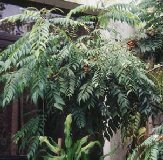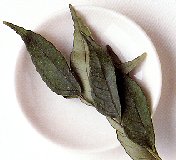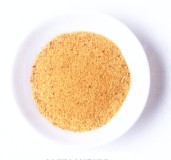Curry
http://www.100md.com
《e Natural Health Center》
 |
 |
 |
 |
Flavorings
Curry
Latin:
Murraya koenigii
Origin:
Curry is a blend of ground spices adapted by British settlers in India from the traditional spice mixtures of Indian cuisine. Curry comes from Tamil kari, meaning "sauce."
It can be said that curry is a British invention to imitate the flavor of Indian cooking with minimal effort. Some curry indeed contains curry leaves, which are absolutely necessary for the authentic flavor, but most commercial curry don't, because dried curry leaves lose their fragrance within days and it's simply not economical to use it.
, http://www.100md.com
The basic ingredients of commercial curry powder are turmeric (which imparts the characteristic yellow color), roasted cumin, roasted coriander, black pepper, and chilies. Other ingredients may include cloves, cinnamon, fenugreek, nutmeg, ginger, mace, mustard seed, fennel, poppyseed, anise, bay leaves, and white pepper, all roasted and ground fine. Remember that since curry powder is not a traditional Indian recipe, there is little consensus about what should go into it, and anyone is free to make his own creation.
, 百拇医药
Indians prepare their mixtures separately for each dish and usually do not store them, thus guaranteeing the unique flavor of each recipe. Curry powder, therefore, belongs more to British or international cuisine than to India. Anyone trying to cook authentic Indian recipes would stick to traditional Indian spice mixtures or, even better, single spices.
Curry leaf of the tree Murraya koenigii Spreng., or Chalcas koenigii, of the Rutaceae (citrus) family, is native to India. Today, it is found wild or become wild again, almost everywhere in the Indian subcontinent excluding the higher levels of the Himalayas. In the East, its range extends into Burma.
, 百拇医药
Curry leaves are extensively used in Southern India and Sri Lanka and are also of some importance in Northern India. Together with South Indian immigrants, curry leaves reached Malaysia, South Africa and Reunion island. Outside the Indian sphere of influence, they are rarely found.
Curry leaves are used fresh; for some recipes, the leaves should be oven-dried or toasted immediately befor usage. Another common technique is short frying in butter or oil. Since South Indian cuisine is dominantly vegetarian, curry leaves seldom appear in non-vegetarian food. The main applications are thin lentil or vegetable curries (sambaar) and stuffings for the crispy samosa. Because of their soft texture, they are never removed before serving, but can be eaten without any hazard.
, 百拇医药
In Sri Lanka, the delicious chicken and beef curries are flavored with curry leaves. The leaves are also used for kottu roti, vegetables and sliced bread which are quickly fried together.
The typical Sri Lankan flavor is due to heavy toasting some spices (cumin, coriander, black mustard, fenugreek) until they reach a rather dark color. It is often said that Sri Lankan curries have a "darker" or "browner" flavor than Indian curries. Sri Lankan cooks often use aromatic spices native to the island (cinnamon, cardamom) and fresh leaves (curry leaves, Pandanus leaves and lemon grass; the latter two are not in common use in India).
, 百拇医药
Curry leaves may be kept in the refrigerator for some time, but are better kept frozen; do not remove them from the branches before usage.
The term curry is applied inflationarily to many dishes of Far Eastern origin. In its true home South India it means a thin, spicy vegetable stew; in Thailand, though, any food cooked in coconut milk is called a curry. Burmese curries owe their flavor to a fried paste of ground onions and other spices. Lastly, in Indonesia, any spicy food may be termed a curry (kari in Indonesian). Sometimes, even Ethiopian or Caribbean recipes are called curries!
, http://www.100md.com
Spicy, gravied dishes have been a mainstay of South Asian cookery since antiquity, perhaps deriving from sour-milk stews. Certain spices have long been known for their antiseptic and preservative properties, particularly in regions lacking natural means of refrigeration.
Properties:
Functions:
Applications:
, 百拇医药 Dosage and Administration:
Cautions on Use:
Reference Materials:
Toxic or Side Effects:
Modern Researches:
According to a new study to be published in the August 15, 2005 issue of Cancer, curcumin, the yellow pigment found in the spice turmeric, which is an ingredient yellow curry powder, inhibits cell growth in melanoma, an especially virulent form of skin cancer that killed more than 7,000 Americans in 2002 alone.
, http://www.100md.com
Researchers at the University of Texas M.D. Anderson Cancer Center administered varied doses of curcumin to three lines of melanoma cells for different lengths of time. The result: apoptosis, a process that causes the normally immortal cancer cells to die like ordinary cells. And it happened whether the cells got a high dose of curcumin for a short time or a low dose for a long time.
How does curcumin stimulate apoptosis? It appears to work by suppressing two proteins in the cancer cells that would ordinarily block the process; curcumin is a sort of molecular double-negative. The researchers believe that curcumin could kill cancer cells, not just in test tubes, but in actual tumors, and they're now preparing for animal testing─and, if that's successful, for clinical trials in humans., http://www.100md.com